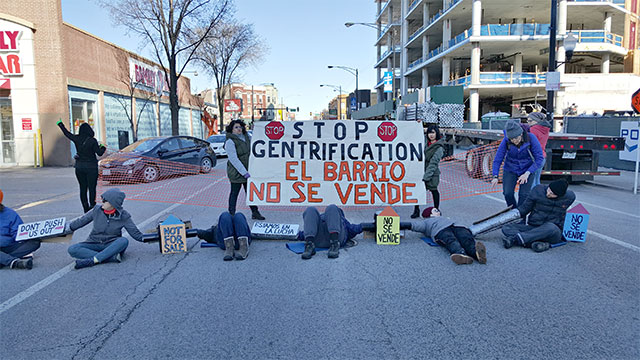
On April 9, 2016, an organized group of Chicagoans locked themselves together, and to four buckets of concrete, to shut down a major thoroughfare in the increasingly gentrified community of Logan Square. The action occurred on Chicago’s Milwaukee Avenue, just outside a construction site where two luxury towers are set to emerge, further driving up rental prices in the area and creating yet another space in which the area’s longtime residents simply cannot afford to live.
This level of escalation came after a long-term effort to negotiate affordable housing guidelines with developers and officials, like the neighborhood’s alderman, Joe Moreno. With every door to dialogue slammed shut, the local organizers of Somos Logan Square teamed up with the direct action collective Lifted Voices to collaborate on a path of escalation for the campaign.
As one of the cofounders of Lifted Voices, I take its mission very seriously. We are a direct action-oriented group, with a particular focus on training and tactical education, which aims to defend the lives of women and non-binary people of color. Our praxis of defense is cultural, political and personal. This action, which addressed the violence of gentrification, provided an opportunity to address a manifestation of the long-waged cultural, political and personal violence that has been perpetrated against us: the violence of colonialism itself.
As a Native woman, I know that not everyone is comfortable with the comparison between gentrification and the displacement of our people, but to truly fight what destroys us, we must name it. And just as the prison industrial complex is the reinvention of American slavery, gentrification is a mere refashioning of colonialist displacement in the United States.
Much like the prison industrial complex, gentrification does not exclusively ensnare the community that displacement practices arose to oppress, but this should not prevent us from understanding who these practices were developed to control and destroy. If we are to understand prisons in the context of slavery and anti-Blackness, and displacement in the context of Native genocide and forced relocation, we must also understand these tools as dynamic. The prison industrial complex and displacement policies are both manufactured and monetized in a variety of ways. It is important that we not allow the tentacles and branding of their harms to distract from what they are: pillars of white supremacy.
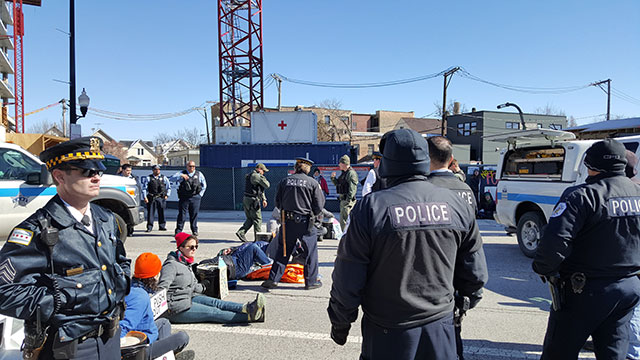 Police surround blockaders and unload cutting equipment to dismantle the blockade. (Photo: Kelly Hayes)
Police surround blockaders and unload cutting equipment to dismantle the blockade. (Photo: Kelly Hayes)
Unwanted People and Unwanted Land
Anyone who is familiar with the history of Chicago’s housing struggles knows that the city was segregated by design. From the practice of redlining to the telling design work of our parks and public transit system, Chicago has long maintained policies of separation and control with regard to its marginalized communities. Resources are concentrated in more affluent or “up-and-coming” communities, while marginalized neighborhoods are treated as containers for the problems of poverty and social neglect. Such communities are often reduced to danger zone stereotypes — the geographical equivalents of boogeymen.
But as history has taught us, the value of land is a fluid thing.
In Chicago’s latest wave of reinvention, we have seen Cabrini Green — once painted as the stuff of nightmares by a media that monstracized its residents — recently declared one of Chicago’s best “up-and-coming” neighborhoods. With its once-famous housing projects long leveled, Cabrini is now a garden where multimillion-dollar developments can grow. Of course, erecting opulent towers where some of the world’s most well-known public housing once stood is far more blatant than what’s playing out in most of our affected neighborhoods. In most communities, gentrification isn’t a wrecking ball that brings down thousands of homes in a single demolition project, but a slow crawl of commercial change that makes life less and less possible for longtime residents.
The predominantly Brown neighborhood of Logan Square is a community whose diversity and affordability are visibly under threat. A 2015 report from the Metropolitan Planning Council shows that the neighborhood’s population decreased by 11.2 percent between 2000 and 2010 as the cost of rent increased. Rising housing costs have left roughly half the neighborhood living in housing-cost-burdened households — meaning residents are forced to spend more than 30 percent of their incomes on housing.
From the devastating closure of a publicly funded mental health clinic in 2012 to the emergence of pricey brunch spots and hip boutiques, a clear picture has emerged of who the neighborhood is now being designed to serve. White residents, who, wittingly or unwittingly, carried out the early stages of the gentrification process by latching onto affordable properties and making the area seem “edgy” and artistic, and just white enough for full settlement, are finding themselves priced out alongside immigrant families.
But resistance is happening. The grassroots group Somos Logan Square has been fighting for more affordable housing in Logan Square since late 2013. The group was born out of efforts to mobilize some of Logan Square’s newer residents in solidarity with longtime residents facing eviction from buildings bought by developer M. Fishman. The organization has held panel discussions that mobilized hundreds of supporters to learn about the dynamics causing gentrification; has helped dozens of tenants win relocation assistance in eviction struggles; and provides ongoing support for tenant associations in several buildings. But in their most recent efforts to address the lack of affordable housing available in new structures like the one Power Construction is building on Milwaukee Avenue, Somos Logan Square found no audience with officials or developers.
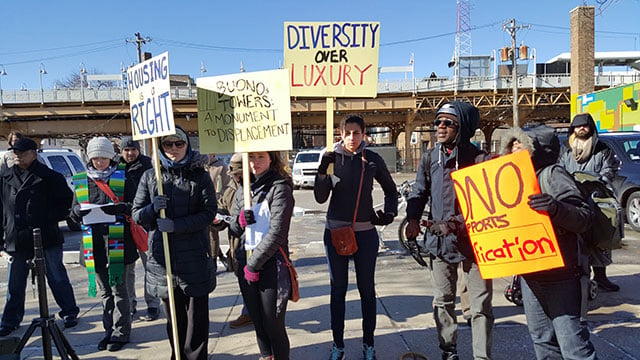 Supporters gather on the sidewalk as the blockade continues. (Photo: Kelly Hayes)
Supporters gather on the sidewalk as the blockade continues. (Photo: Kelly Hayes)
Drawing a Line With Our Bodies
Having pursued every practical avenue to address their concerns and grievances, community members fighting for their homes in Logan Square were left with no option but to escalate. Working in concert with our direct action collective, Lifted Voices, Somos Logan Square participated in a month-long education series in direct action organizing and tactics. At the end of this marathon learning session, the Milwaukee Avenue blockade was staged.
On a Saturday morning, six participants locked themselves down in the road. The deployment of blockaders was quickly surrounded by dozens of supporters, as a second blockade line formed along the entrance to the construction site.
The action was largely designed and led by Brown women, but the undertaking itself was unmistakably interracial. Organizers whose peoples are most impacted by gentrification were joined by a number of white allies, some of whom held space on behalf of co-strugglers who could not risk arrest due to their marginalized status. White people who undertake risks such as these, in opposition to harms that are largely steeped in whiteness, recognize that rejecting white supremacy means betraying a system that was designed to benefit them. In this context, that means resisting the practices of displacement that phase out Brown and Black residents and businesses in favor of trendy boutiques and brunch spots.
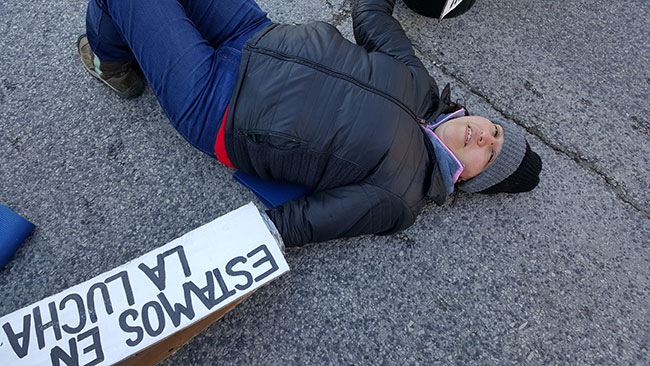 Alicia Avila rests her back against the pavement as she settles into her blockade equipment. (Photo: Kelly Hayes)
Alicia Avila rests her back against the pavement as she settles into her blockade equipment. (Photo: Kelly Hayes)
“They are building over 300 apartments here,” said blockader Alicia Avila, “and we need 30 percent of those units to be affordable housing that members of the community can live in. They are offering 10 [percent], which is basically nothing.” Laying flat on cold pavement, with one arm in PVC and the other locked inside a bucket of concrete, Avila added, “People in the neighborhood are being displaced by this, and I am here for them.”
“We’re trying to stop the sale of our community,” said blockader Sally Hamann, as she locked into her equipment. Hamann is 68, and she’s lived in Logan Square for 36 years. Hamann noted that Alderman Joe Moreno, a strong supporter of what Hamann referred to as “these ugly towers, that the community doesn’t want,” was also spearheading efforts to eliminate 525 affordable housing units in the community.
Both Avila and Hamann disregarded continued orders from police to unlock from their blockade devices. Eventually, a SWAT team surrounded the blockade line, and slowly destroyed the lockboxes and concrete buckets, which latched the group together, with angle grinders and mallets. It was a terrifying sight for many who watched supportively from the sidewalk, but the group held strong through their removal. By the time they were taken into custody, the six blockaders had exceeded their goal of holding the street for two full hours. All six arrestees emerged from jail hours later, declaring that they were proud of each other and of their community. It was heartening to see people of different ages and backgrounds, none of whom had previously engaged in civil disobedience, bounce back from the thunder of mallets and machines, and smile in the knowledge that they did what they had to, because sometimes, building a better world means bringing the one you live in to a standstill.
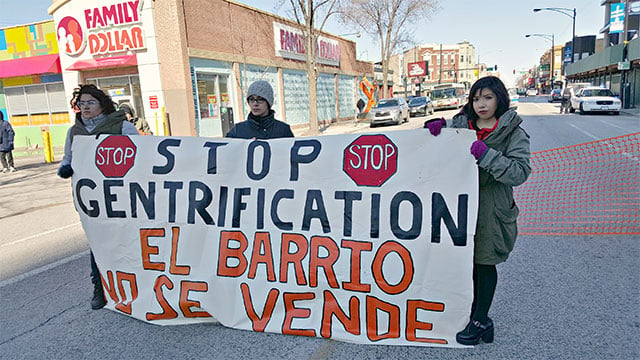 Three members of Lifted Voices hold a banner on Milwaukee Avenue. (Photo: Kelly Hayes)
Three members of Lifted Voices hold a banner on Milwaukee Avenue. (Photo: Kelly Hayes)
In Lifted Voices, we are committed to seeing this kind of escalation against gentrification continue in our city, and beyond, but we also implore marginalized people to understand the need to escalate on other fronts and at the intersections of our respective struggles. Lifted Voices members — militant women and non-binary people of color — worked with this multiracial group of organizers in the same spirit of solidarity that once brought the Black Panthers, the Young Patriots and the Young Lords into common cause in our city. As a group focused on the defense of women and non-binary people of color, we recognize that the intersections of our oppressions are not simply a common point along our forward paths. The intersections where our oppressions, identities and struggles connect are in fact a tangled webwork of overlapping issues and experiences. We have a great deal in common with the multiracial group Somos Logan Square, and we believe interconnected oppressions call for interconnected resistance. Because we are all going to need each other to get free.
But to truly liberate ourselves in the face of oppression, we will need more than unity. We will need severity. We will need ferocity and creativity. We will need group dynamics that upend oppressions, rather than recreate them. And we will need to fight as unflinchingly as the forces that move against us.
The lines that divide us, that tell us where and how to live, have been drawn by moneyed colonial power for far too long. It is time for us to draw our own lines, and to take up the task of building. If they can build posh towers where our homes, schools and clinics should be, we can build powerful community, and even blockades, on the streets they seek to take. We can disrupt both their theft and their comfort — and occasionally, their brunch.
In concrete, in PVC, and with breathing human bodies, we drew a line that day. Because this is what we’ve come to in struggle and this is what it will take to get free. This and so much more.
Join us in defending the truth before it’s too late
The future of independent journalism is uncertain, and the consequences of losing it are too grave to ignore. To ensure Truthout remains safe, strong, and free, we need to raise $43,000 in the next 6 days. Every dollar raised goes directly toward the costs of producing news you can trust.
Please give what you can — because by supporting us with a tax-deductible donation, you’re not just preserving a source of news, you’re helping to safeguard what’s left of our democracy.